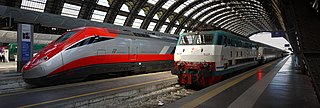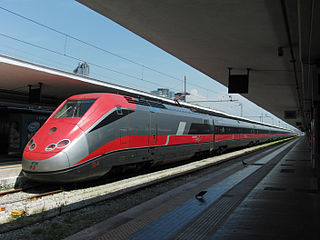| FS class E.326 | |||||||||||||||||||||||||||||
|---|---|---|---|---|---|---|---|---|---|---|---|---|---|---|---|---|---|---|---|---|---|---|---|---|---|---|---|---|---|
 | |||||||||||||||||||||||||||||
| |||||||||||||||||||||||||||||
| |||||||||||||||||||||||||||||
| |||||||||||||||||||||||||||||
| |||||||||||||||||||||||||||||
The FS E.326 was a class of Italian railways electric locomotives. Designed in 1929, they were introduced in the early 1930s, for hauling light express passenger trains at high speeds.
| FS class E.326 | |||||||||||||||||||||||||||||
|---|---|---|---|---|---|---|---|---|---|---|---|---|---|---|---|---|---|---|---|---|---|---|---|---|---|---|---|---|---|
 | |||||||||||||||||||||||||||||
| |||||||||||||||||||||||||||||
| |||||||||||||||||||||||||||||
| |||||||||||||||||||||||||||||
| |||||||||||||||||||||||||||||
The FS E.326 was a class of Italian railways electric locomotives. Designed in 1929, they were introduced in the early 1930s, for hauling light express passenger trains at high speeds.
The E.326 was part of family of locomotives designed under engineer Giuseppe Bianchi in the 1920s and in 1930s for Italy's state railways, which, through the use of a great number of standardized components, would mean benefits such as reduced maintenance costs, easier repairs and more familiarity of the personnel. These included the E.428, designed for heavy passenger trains, the E.626, for heavy freight and passenger trains on secondary lines, and the E.326, for hauling light, fast passenger trains. The design reflected contemporary steam engine practice, with six large driving wheels and two bogies. The concept of the locomotive may have been inspired by Vincent Raven's NER No. 13 prototype. The E.326 had six motors, like the E.626. It was designed and built before the eight-motor E.428. [1]
The FS ordered two prototypes from Società Italiana Ernesto Breda on 5 March 1929, which were outshopped respectively in July and December 1930. After the first successful trials on the Foggia-Benevento line (then the only FS line electrified at 3 kV DC), a series of 10 production locomotives was ordered in December 1930, and they were outshopped from November 1932 to January 1933, with some minor improvements. In 1933 the FS designed another series of E.326, which would have sported smaller driving wheels (identical to those of the E.428) and modified auxiliaries, but the better performance of the E.428 and the ETR.200 project meant that they were not built. [2]
During the tests on the Bologna-Florence line (then being completed), one of the locomotives, having a nominal maximum output of 2,100 kW (2,800 hp), managed to reach a top speed of 140 km/h (87 mph), although the certified top speed was set at 130 km/h (81 mph). Officially, the top speed permitted on any line was still 120 km/h). The E.326 worked on the Bologna-Florence line from its opening on 22 April 1934, hauling express trains. [3]
In April 1935 four locomotives were re-assigned to the Naples shed, for service on the new Rome-Naples line, and by July 1936 all twelve had been concentrated in Rome. However, both the E.326 and the E.428 suffered poor riding at speed that forced a temporary reduction of their top speed to 105 km/h (65 mph). The E.428's issues were successfully solved, but those of the E.326 (which also tended to derail when going through a crossing switch) lingered. The FS tested several modifications to the chassis, including radically modifying the bogies, reducing the central driving wheel flanges and fitting pneumatic cylinders to the bogies, but the irregularities remained and so did the reduction to their top speed. These issues, together with the increased availability of the E.428, and the appearance of the ETR.200 for long-distance express trains, meant that from 1936 the E.326 were largely relegated to secondary services, and were reassigned to Bologna. [4]
During World War II, all 12 units were damaged by Allied bombings. They were repaired in the Foligno workshop (except 006, repaired at Bologna), and returned to service in 1949 with a simplified electrical arrangement (similar to that of the more recent E.626). Despite further tests to improve their mechanical behaviour, the E.326's top speed was further reduced to 90 km/h (56 mph) in 1963. They hauled mostly local passenger trains to Padua, Piacenza and Ancona. The E.326s were slated for withdrawal in March 1979, and by December 1982 all were out of service, with the last one active being E.326.005. [5]
After withdrawal, E.326.004 was thoroughly repaired and repainted, and is currently statically preserved in the Pietrarsa railway museum, near Naples. [6]

A tilting train is a train that has a mechanism enabling increased speed on regular rail tracks. As a train rounds a curve at speed, objects inside the train experience centrifugal force. This can cause packages to slide about or seated passengers to feel squashed by the outboard armrest, and standing passengers to lose their balance. Tilting trains are designed to counteract this by tilting the carriages towards the inside of the curve, thus compensating for the g-force. The train may be constructed such that inertial forces cause the tilting, or it may have a computer-controlled powered mechanism.

A streamliner is a vehicle incorporating streamlining in a shape providing reduced air resistance. The term is applied to high-speed railway trainsets of the 1930s to 1950s, and to their successor "bullet trains". Less commonly, the term is applied to fully faired upright and recumbent bicycles. As part of the Streamline Moderne trend, the term was applied to passenger cars, trucks, and other types of light-, medium-, or heavy-duty vehicles, but now vehicle streamlining is so prevalent that it is not an outstanding characteristic. In land speed racing, it is a term applied to the long, slender, custom built, high-speed vehicles with enclosed wheels.

The Italian railway system is one of the most important parts of the infrastructure of Italy, with a total length of 24,227 km (15,054 mi) of which active lines are 16,723 km. The network has recently grown with the construction of the new high-speed rail network. Italy is a member of the International Union of Railways (UIC). The UIC Country Code for Italy is 83.

The FS E.645 and E.646 are two classes of similar electric locomotives used on Italian railways. They were introduced during the 1950s and they were retired in 2009.

The FS E.636 is a class of Italian articulated electric locomotives. They were introduced in the course of the 1940s until the 1960s, and have been decommissioned since 2006. They have been one of the most numerous Italian locomotive group, and have been widely employed during their long career, hauling every type of train, ranging from freight to long range passenger services. Their introduction also saw the employment of some revolutionary design concepts, such as the articulated carbody and the three bogies scheme.

The Italian railway system is one of the most important parts of the infrastructure of Italy, with a total length of 24,227 km (15,054 mi) as of 2011.

High-speed rail in Italy consists of two lines connecting most of the country's major cities. The first line connects Turin to Salerno via Milan, Bologna, Florence, Rome and Naples, the second runs from Turin to Venice via Milan and Verona, and is under construction in parts. Trains are operated with a top speed of 300 km/h (190 mph).

The ETR 200 is an Italian electric multiple unit (EMU) introduced in 1936.

The FS E.444 is a class of Italian railways electric locomotives. They were introduced in the course of the 1960s until 1975. Starting from 1989, all E.444s were upgraded as E.444R.

The FS E.632 and E.633 are two classes of Italian railways electric locomotives. They were introduced in the course of the 1980s.

The FS E.625 and E.626 are two classes of Italian electric locomotives produced for the Ferrovie dello Stato. They were introduced in the course of the 1920s and remained in service until the 1990s. The E.626 was the first locomotive fed by 3,000 V DC overhead line in Italy.

The FS E.428 was a class of Italian railways electric locomotives. They were introduced in the course of the 1930s, for fast services on the Florence–Rome railway, being decommissioned in the 1980s.
Giuseppe Bianchi was an Italian railway engineer on the Ferrovie dello Stato between 1913 and 1946.

The Milan–Bologna railway is the northern part of the traditional main north–south trunk line of the Italian railway network. It closely follows the ancient Roman Road, the Via Aemilia. The line was opened between 1859 and 1861 as a single-line railway, and was doubled between 1866 and 1894. It was electrified at 3,000 volts DC in 1938. High-speed trains on the route have used the parallel Milan–Bologna high-speed line since 13 December 2008.

ETR 500 is a family of Italian high-speed trains built by AnsaldoBreda and introduced in 1993.

The Frecciarossa 1000, is a high-speed train operated by Italian state railway operator Trenitalia. It was co-developed as a joint venture between Italian rail manufacturer Hitachi Rail Italy and multinational conglomerate Alstom. Both design and production work were divided between the two partner companies.

The Ferrovie dello Stato Class 685 is a class of 2-6-2 'Prairie' express train steam locomotives. These are colloquially known as Regine, mirroring their fame as one of the most successful and appreciated Italian steam locomotives.

The Ferrovie dello Stato Italiane Class 680 is a 2-6-2 express steam locomotive; it was the direct ancestor of the very successful and appreciated Class 685.

The FS Class E.431 was a class of three-phase AC electric locomotives of the Italian State Railways (FS).

FS Class E.333 was a class of electric locomotives of the Ferrovie dello Stato (FS), powered by three-phase alternating current, which were in service from 1923 to 1968. They were designed by Kálmán Kandó for hauling fast passenger trains. Having the same electrical equipment as the FS Class E.552 locomotives, they presented the same defects and had to be modified. After modification, they were able to carry out the services for which they were designed.